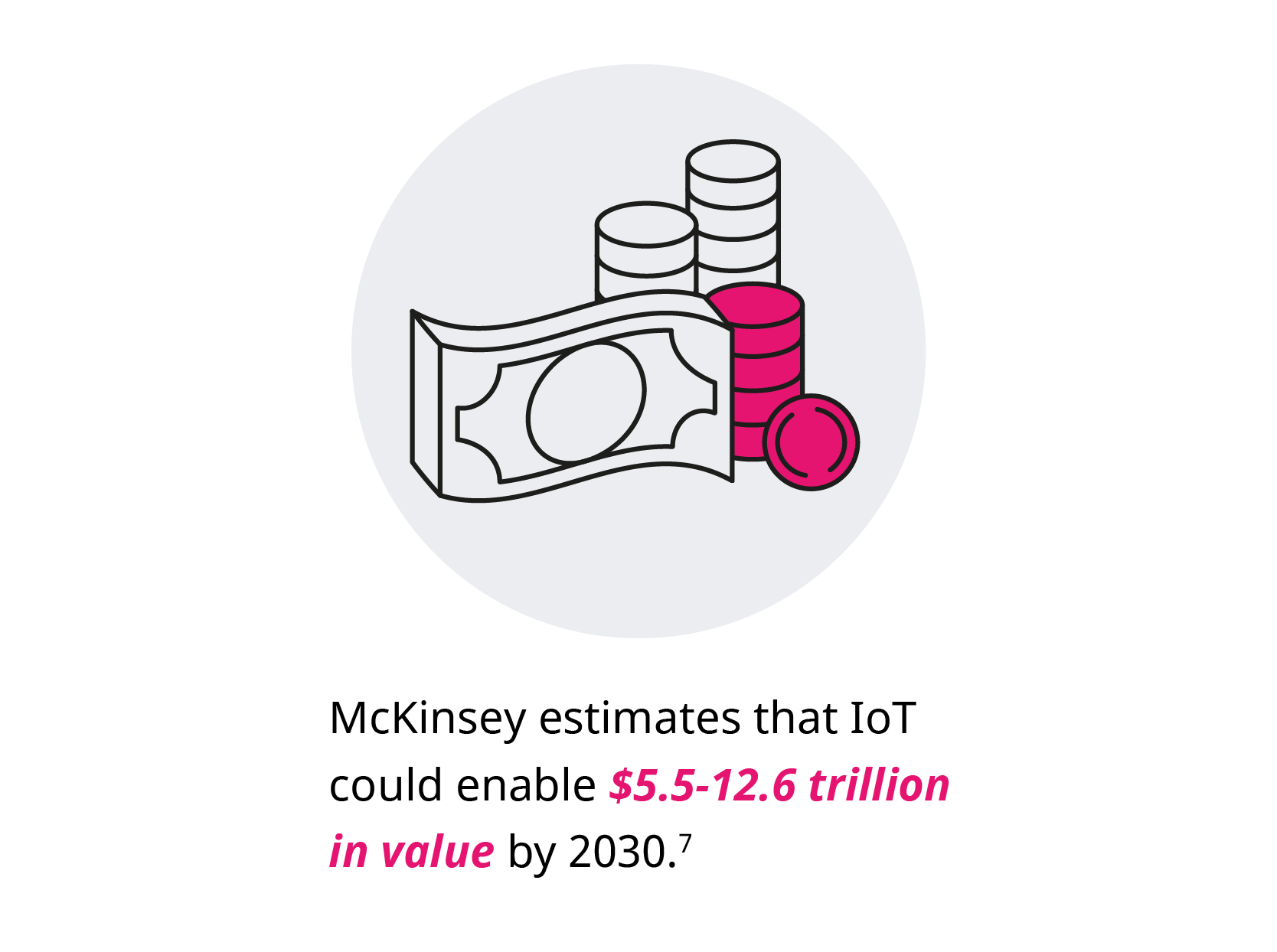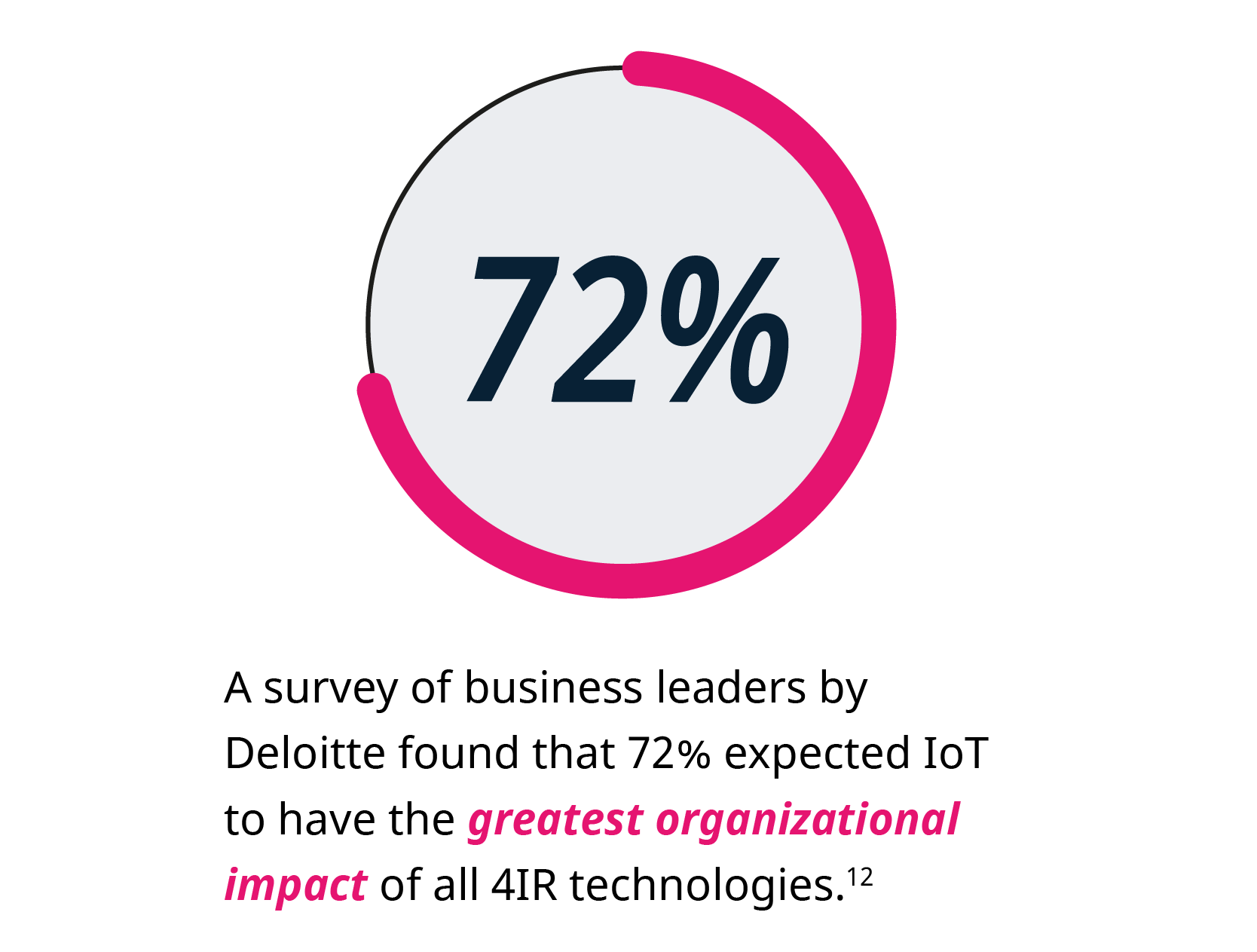What Are the Management Implications of the Internet of Things?
The number of computing devices, including cellphones, computers, and tablets, in use in 2021 was estimated to be 6.2 billion, according to Gartner.1 The number of Internet of Things (IoT) devices is even greater, with estimates ranging from 14.5 billion2 to more than 46 billion.3 That number is expected to grow exponentially in the coming years.
While IoT innovation has technological applications that facilitate operational efficiencies, communication, and data collection, IoT is not a technology. Rather, it’s a leadership opportunity: the mechanism you need to transform your business and revamp traditional management approaches.
What is the Internet of Things?
IoT can be defined as the network of everyday devices equipped with sensors and able to connect with other devices and systems via the internet.4 Despite the name, devices can also be connected via other mediums such as Bluetooth or near-field communication.5
Examples of IoT devices include cars, baby monitors, thermostats, and kitchen appliances.6 All of these things form a network, connecting people to people, people to tech, and tech to tech, to ultimately form the Internet of Things. Although the technologies that underpin the IoT are not new, their modern application as part of a unified system has huge implications for businesses.
How will IoT innovation affect management?

Here are three examples of how the adoption of IoT technology could impact the way you lead and manage:
1. Reduce time wastage
One of the greatest IoT impacts for businesses is the ability to get more done in less time.
McKinsey estimates that improvements in operations and human productivity could account for 56 percent of IoT’s economic value by 2030. IoT has the potential to impact almost any industry, from insurance and human resources to construction, agriculture, and healthcare.8
A study by Ericsson Research found that an increase in cellular IoT connections of 10 percent resulted in a 0.23 percent increase in productivity growth.9 That doesn’t sound like much, but it equates to around $195 billion.
Consider the applications in facilities management, for example. IoT allows for facilities to be monitored automatically at a more detailed level and for maintenance to be coordinated accordingly. IoT sensors in equipment can automatically trigger alerts in the event of failure, reducing downtime.10 These sensors mean people can track key assets in real time, increasing supply chain transparency, and identifying issues or complications immediately.11

2. Increase team collaboration
Much has been written about the paradox of technological interconnectedness, especially social media, which research has shown actually makes us feel lonelier.13
However, in terms of collaboration, IoT holds the potential to connect rather than isolate and to improve rather than degenerate.
IoT sensors generate an enormous amount of data. When connected to communication solutions through application programming interfaces that collect and analyze data, this information can enable much faster decision-making and collaboration. Equipment fitted with IoT sensors can communicate information about its status to operators, engineers, and managers simultaneously, enabling them to formulate appropriate strategies collaboratively and using the most up-to-date data.14
Similarly, issues in a complex environment like logistics can be viewed by all relevant stakeholders and decision-makers along the supply chain with the help of IoT. Having this sort of holistic view can encourage more effective collaboration and break down the silos that exist between disparate suppliers and locations.15
3. Limit costs
When machines are enhanced and maintained in order to operate in newer and smoother ways, running costs are naturally reduced. IoT integration can improve your company’s bottom line in a number of ways:
- Inventory costs: Attaching IoT sensors to pallets, for example, can track their movements throughout the supply chain, providing crucial information that can improve inventory management and also reduce pallet loss. Using RFID tags, smart shelving units can monitor inventory automatically, allowing businesses to stock up timeously.16
- Maintenance costs: Using information from IoT sensors on key equipment, managers can be informed about what parts are likely to need replacing and when, and are thus able to store only the necessary ones at the right times. This reduces parts inventory, downtime, and the degree of repairs that need to be carried out.17
- Electricity costs: IoT devices facilitate smart grid architecture, metering, and coordination. Real-time power usage monitoring can help you track which processes consume power and build data-driven models to manage energy usage better moving forward.18
- Labor costs: Research has found that 83 percent of organizations that deployed IoT solutions reported an increase in business efficiency.19 Coupled with decreased and more targeted maintenance, it’s clear how this can ensure that labor is used more efficiently.
With the cost of sensors reducing and adoption growing, IoT is impacting business across the board, and IoT device management and knowledge are fast becoming essential skills. The challenge for business leaders is to know how to identify the most important and cost-effective applications of this technology for their particular working context.
The Internet of Things: Business Implications and Opportunities online short course from the MIT Sloan School of Management provides insight into the benefits and impact of IoT adoption on an organizational level. Over six weeks, you’ll gain the skills and knowledge to create a practical roadmap for the real-world implementation of IoT.
Start experiencing the efficiencies and innovation that IoT brings to business
- 1 (Apr, 2021). ‘Gartner forecasts global devices installed base to reach 6.2 billion units in 2021’. Retrieved from Gartner.
- 2 Sinha, S. (Sep, 2021). ‘State of IoT 2021: Number of connected IoT devices growing 9% to 12.3 billion globally, cellular IoT now surpassing 2 billion’. Retrieved from IoT Analytics.
- 3 G., N. (Feb, 2022). ‘How many IoT devices are there in 2022? [All you need to know]’. Retrieved from Techjury.
- 4 (Nd). ‘What is IoT?’ Retrieved from Oracle. Accessed March 7, 2022
- 5 Kenton, W. (May, 2021). ‘The Internet of Things (IoT)’. Retrieved from Investopedia.
- 6 (Nd). ‘What is IoT?’ Retrieved from Oracle. Accessed March 7, 2022
- 7 Chui, M., et al. (Nov, 2021). ‘The Internet of Things: Catching up to an accelerating opportunity’. Retrieved from McKinsey.
- 8 Chui, M., et al. (Nov, 2021). ‘The Internet of Things: Catching up to an accelerating opportunity’. Retrieved from McKinsey.
- 9 Edquist, H. (May, 2020). ‘Is there a link between IoT and productivity growth?’ Retrieved from Ericsson.
- 10 (Oct, 2021). ‘How IoT transforms facilities management processes’. Retrieved from IoT for all.
- 11 Postol, A. (Jun, 2021). ‘How manufacturers use IoT to improve operational efficiency’. Retrieved from Lanars.
- 12 (2020). ‘The Fourth Industrial Revolution’. Retrieved from Deloitte.
- 13 Katz, L. (Jun, 2020). ‘How tech and social media are making us feel lonelier than ever’. Retrieved from CNET.
- 14 Yin, D. (May, 2020). ‘What is the Internet of Things (IoT) and collaboration’. Retrieved from RingCentral.
- 15 Bryan, D. (May, 2020). ‘Four ways to help improve the supply chain with the Internet of Things (IoT)’. Retrieved from Supply Chain Digital.
- 16 Bielak, M. (Sep, 2021). ‘Can IoT make your retail inventory management lossproof?’ Retrieved from Netguru.
- 17 Bither, B. (Aug, 2020). ‘5 Ways industrial IoT reduces costs for manufacturers’. Retrieved from MachineMetrics.
- 18 (Feb, 2022). ‘10 Benefits of smart energy management using IoT (Internet of Things)’. Retrieved from Digiteum.
- 19 Jovanovic, B. (Mar, 2022). ‘Internet of Things statistics for 2022 – taking things apart’. Retrieved from DataProt.
